

France. France (UK: /ˈfrɑːns/; US: i/ˈfræns/; French: [fʁɑ̃s] ( )), officially the French Republic (French: République française [ʁepyblik fʁɑ̃sɛz]), is a sovereign country in Western Europe that includes overseas regions and territories.
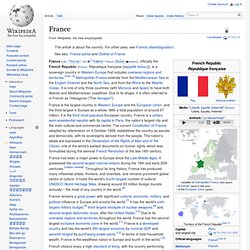
[note 13] Metropolitan France extends from the Mediterranean Sea to the English Channel and the North Sea, and from the Rhine to the Atlantic Ocean. It is one of only three countries (with Morocco and Spain) to have both Atlantic and Mediterranean coastlines. Due to its shape, it is often referred to in French as l’Hexagone ("The Hexagon"). France is the largest country in Western Europe and the European Union, and the third-largest in Europe as a whole. France has been a major power in Europe since the Late Middle Ages. Etymology History Prehistory One of the Lascaux paintings of which depicts a horse (Dordogne, approximately 18,000 BC). Gaul Kingdom of Francia (3rd century–843) The last Merovingian kings lost power to their mayors of the palace (head of household). Germany.
Germany ( i/ˈdʒɜrməni/; German: Deutschland), officially the Federal Republic of Germany (German: Bundesrepublik Deutschland, pronounced [ˈbʊndəsʁepuˌbliːk ˈdɔʏtʃlant]),[7] is a federal parliamentary republic in western-central Europe.
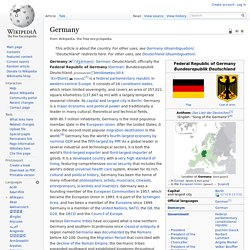
It consists of 16 constituent states, which retain limited sovereignty, and covers an area of 357,021 square kilometres (137,847 sq mi) with a largely temperate seasonal climate. Its capital and largest city is Berlin. Germany is a major economic and political power and traditionally a leader in many cultural, theoretical and technical fields. §Etymology §History §Prehistory §Germanic tribes and Frankish Empire Second- to fifth-century migrations in Europe. Ireland. Ireland (locally: /ˈɑːrlənd/; RP: /ˈaɪələnd/; GA: i/ˈaɪərlənd/; Irish: Éire [ˈeːɾʲə] ( Politically, Ireland is divided between the Republic of Ireland, which covers five-sixths of the island, and Northern Ireland, a part of the United Kingdom, which covers the remaining area and is located in the north-east of the island.
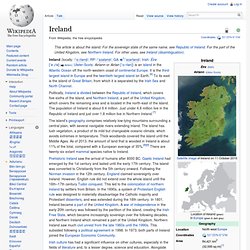
The population of Ireland is about 6.4 million. Just under 4.6 million live in the Republic of Ireland and just over 1.8 million live in Northern Ireland.[7] The island's geography comprises relatively low-lying mountains surrounding a central plain, with several navigable rivers extending inland. Prehistoric Ireland saw the arrival of humans after 8000 BC. Irish culture has had a significant influence on other cultures, especially in the fields of literature and, to a lesser degree, science and education. History Prehistoric Ireland During the last glacial period, and up until about 9000 years ago, most of Ireland was covered with ice. Emergence of Celtic Ireland. Poland. Poland i/ˈpoʊlənd/ (Polish: Polska), officially the Republic of Poland (Polish: Rzeczpospolita Polska), is a country in Central Europe, bordered by Germany to the west; the Czech Republic and Slovakia to the south; Ukraine, Belarus to the east; and the Baltic Sea and Kaliningrad Oblast (a Russian exclave) and Lithuania to the north.
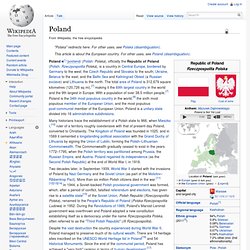
The total area of Poland is 312,679 square kilometres (120,726 sq mi),[7] making it the 69th largest country in the world and the 9th largest in Europe. With a population of over 38.5 million people,[7] Poland is the 34th most populous country in the world,[9] the sixth most populous member of the European Union, and the most populous post-communist member of the European Union.
Poland is a unitary state divided into 16 administrative subdivisions. Spain. Spain ( i/ˈspeɪn/; Spanish: España [esˈpaɲa] ( )), officially the Kingdom of Spain (Spanish: Reino de España),[c][7] is a sovereign state and a member state of the European Union.
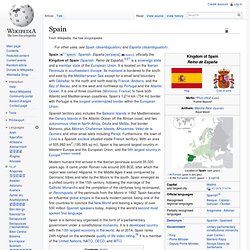
It is located on the Iberian Peninsula in southwestern Europe. Its mainland is bordered to the south and east by the Mediterranean Sea except for a small land boundary with Gibraltar; to the north and north east by France, Andorra, and the Bay of Biscay; and to the west and northwest by Portugal and the Atlantic Ocean. It is one of three countries (Morocco, France) to have both Atlantic and Mediterranean coastlines. Spanish territory also includes the Balearic Islands in the Mediterranean, the Canary Islands in the Atlantic Ocean off the African coast, and two autonomous cities in North Africa, Ceuta and Melilla, that border Morocco, plus Alborán, Chafarinas Islands, Alhucemas, Vélez de la Gomera and other small islets including Perejil.
Etymology Treasure of Villena, a Bronze Age treasure hoard. History.